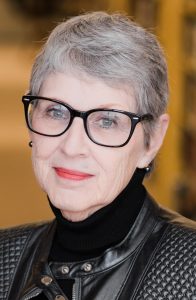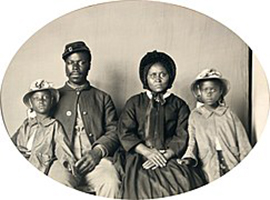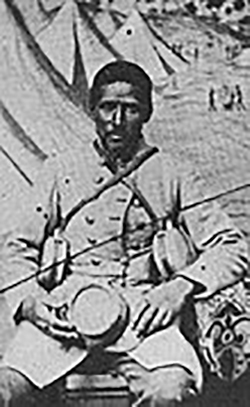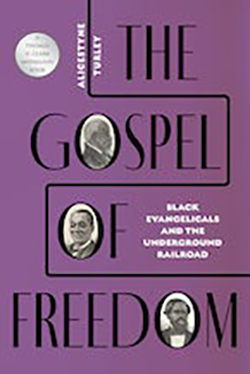“How many teachers? How many military? Any historians?” Dr. Alicestyne Turley polled the audience as she began her recent “Evening Upstairs” presentation at the McCracken County Public Library.
And then she asked, “Any Confederates here who want to argue about the causes of the Civil War?”
There were no takers.
To set the record straight on an array of issues associated with African Americans, Kentucky, and the Civil War, Turley exploded some prevailing myths. For example, she was emphatic in identifying slavery as the cause of the Civil War. Although she agreed that States Rights was a contributing factor, she pointed to the fundamental need for slavery as the basis of the South’s agrarian economy.
The Confederate States were willing to go to war to preserve the institution, but the North was not off the hook when it came to slavery either.
“Slavery was an American institution,” she declared. “There was no place you could go where slavery didn’t exist.”
She showed a map depicting the slave population in the United States as of 1860 to illustrate her point. When someone questioned why Florida was not populated with many slaves like the rest of the South at that time, Turley explained that it was still Indian Territory, with mostly Seminoles in residence. She added that there were also Blacks, escaped slaves, who had fled to Florida and intermixed with the Native population, “which is why Seminoles were not given Native American status,” she remarked.
The Seminole Tribe of Florida did not receive federal recognition until 1957. According to the Florida Department of State, “Florida Indians collectively became known as Seminole, a name meaning ‘wild people’ or ‘runaway.’”
With slavery solidly entrenched in 1860, the U.S. edged closer and closer to civil war, with strong Kentucky connections emerging on both sides.
Although Illinois claims Abraham Lincoln as their native son, he was born in Kentucky and married a woman from Lexington, daughter of a slaveholding family. Lincoln got his first close look at slavery in practice when he worked as a boatman in Kentucky.
Another Kentuckian, Jefferson Davis, was born in Fairview, on the boundary between Christian and Todd Counties. Today a 351-foot obelisk, constructed on a foundation of solid Kentucky limestone, memorializes Davis, president of the Confederacy, at the state historic site.
The opposing leaders at Fort Sumter, the first battle of the Civil War, had both attended the U.S. Military Academy. On the Union side, Major Robert Anderson, another Kentuckian, surrendered to General P.G.T. Beauregard, from Louisiana.
The two portraits above, both sourced from Wikimedia Commons and in the public domain, illustrate similarities and differences between Blacks’ involvement in Union and Confederacy military.
On the left is an unidentified family of a Black American soldier in Union uniform. The other portrait is a Civil War era Black man in the uniform of a body servant of a Confederate soldier.
When the idea of Blacks fighting as soldiers first came up, Lincoln rejected it. With the Emancipation Proclamation, however, Blacks could formally enlist in military service on the Union side.

“They had uniforms and were recognized as fighting men,” Turley said.
In the South, Jefferson Davis nixed the idea, although slaves could accompany their owners when they served.
“They could be sent to the front lines,” Turley explained, “but they were not uniformed or armed.”
On May 22, 1863, the U.S. War Department issues General Order 143, designating the formation of the Bureau of Colored Troops. Recruiting posters claimed, “Fail now and our race is doomed.” Another one blared, “Men of Color, To Arms!”
Kentucky was the last state to permit Black recruitment and enlistment, but that did not slow down the formation of 163 fighting units of Blacks, about 10% of Union forces.
In March, 1864, war raged on. Confederate general Nathan Bedford Forrest conducted supply raids in western Kentucky and Tennessee. The raid on Paducah, intended to disrupt Union supply lines and also discourage African Americas from enlisting in the Union Army, ended up with Union troops retreating to Fort Anderson. When Forrest demanded unconditional surrender, Colonel Steven Hicks refused and the pillage of Paducah by Confederate troops destroyed buildings and captured needed supplies.
That April, Fort Pillow, Tenn., was held by a Union garrison of about 600 men, approximately half of whom were Black soldiers. On the morning of April 12, Forrest’s force, estimated at 1,500 to 2,500 troops, quickly surrounded and eventually stormed the fort. After the Confederate demand that Union soldiers lay down their arms, with a promise they would not be killed, a massacre of Blacks ensued. As a result of the Confederate refusal to treat all soldiers as traditional prisoners of war, three-hundred and fifty-four colored troops were killed.
“Remember Fort Pillow” became a battle cry thereon.
With so much information to share, Dr. Turley encouraged the audience to use the public library and other resources to learn more about the history of Blacks in the Civil War and reminded the group she would be back in Paducah for another presentation April 28. She ended by delineating the difference between historic observances associated with Juneteenth and August 8.
Dr. Turley explained why, in our region, emancipation is celebrated on August 8, as opposed to Juneteenth. The August date was when Tennessee’s Andrew Johnson freed his personal slaves in 1863. Juneteenth began in Texas, marking June 19, 1865, as the day enslaved African Americans in Texas were told they were free.
“I’m not telling you anything I haven’t researched,” Turley declared.
Afterwards, the audience was invited to stay and talk to Dr. Turley. She answered more questions and was also available to sign copies of her groundbreaking book, “The Gospel of Freedom: Black Evangelicals and the Underground Railroad,” recently published by University Press of Kentucky.
“This writing places enslaved African Americans at the center of their freedom struggle with the understanding that American abolitionism was a sustained international freedom movement driven by the determination of an unseen black community,” Dr. Turley wrote in the introduction.



















